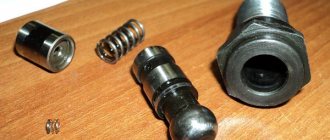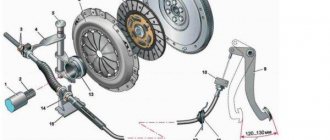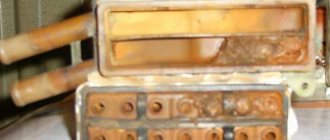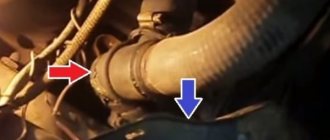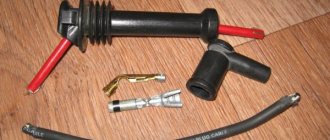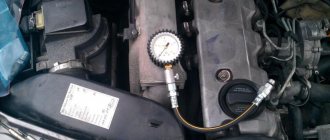Compression is the pressure in the engine cylinders that is created at the end of the compression stroke. If the compression is too high, the concentration of the air-fuel mixture will be high, causing rapid ignition and explosions. As a result, the engine will begin to collapse.
Low compression reduces engine power, dynamics decrease, and it is not possible to reach maximum speed. Plus, fuel and oil consumption increases noticeably.
At low pressure (compression), the air-fuel mixture ignites slowly, causing the engine to heat up. Destructive consequences are inevitable if the problem is not addressed.
Standard pressure gauge for testing
Engine compression VAZ 2110
For some reason, many car enthusiasts confuse the concepts of compression and compression ratio.
By the way, despite their similarity, they are not the same thing. This is approximately the same as the angle of the closed state of the contacts and the ignition timing angle. It is enough to note that the compression ratio is a geometric value, expressed in absolute units (in other words, it is simply data that is not measured in any units), they are practically constant for engines of the same model, if they have not been modified, but are in the standard configuration . Compression, in turn, is measured in pressure units (bar, MPa, atmospheres), its readings strongly depend on the measurement method and the technical condition of the car. Now we will tell you about what compression of a VAZ 2110 engine is. Compression is a physical quantity that determines the pressure that is formed in the cylinder at the end of the compression stroke of the mixture. It is measured in kg/cm2 or atmospheres; less often you can find measurements in kilopascals, bars and other units. Compression can change dramatically as it wears. It may depend on the compression ratio (the optimal engine compression can be considered an approximately calculated value by multiplying the compression ratio by 1.5 atm - this is due to the effect of adiabatic compression). As a result, the characteristic compression values for a standard VAZ 2110 engine will be approximately 7-9 atmospheres. (If the engine is forced, the compression may change to 11-13 atm.).
The meaning of compression is the technical condition of the engine and the entire machine as a whole, along with oil pressure. The higher the compression level, the fewer gases will break into the engine crankcase and, therefore, more gases will do useful work, and the power will also increase. Oil consumption, throttle response, engine stability, engine starting speed, fuel consumption will all depend on the compression level. In addition to all this, the compression value can be affected by the condition of the electrical equipment (battery, starter, connecting wires) when it is measured.
When compression drops in any of the VAZ 2110 cylinders (perhaps this happens in all cylinders at the same time) or compression levels are different in all cylinders, the engine will need to be repaired. Often the main reason for a drop in compression is worn out piston rings, for example, after overheating. In second place are valves. Then a breakdown of the cylinder head gasket. There may also be exotic reasons, such as a piston pin that has come out, or a burnt piston that has “milled” the liner. In order to determine the cause of the drop and imbalance of compression, oil is poured into the cylinder, after which the compression is measured again. If at the same time it increases significantly, then in most cases it is the rings that are to blame. If not, the problem is most likely in the valves or head.
The main significant problems that low compression causes are a drop in power, a decrease in maximum speed, deterioration in acceleration dynamics, and an increase in the amount of consumed fuel and oil - sometimes this is very noticeable.
To measure the compression of a VAZ 2110, you need to use a special device - a compression meter, which looks like a regular pressure gauge, with which the tire pressure will be measured. This device has a special adapter that must be screwed into the candles, or simply pressed tightly against the hole with a rubber ring. The adapter has a nipple or spool that allows you to save the instrument readings for easy reading. Such compression meters can be purchased at any automotive market.
Compression is often measured in two versions: advanced - with closed valves in the carburetor, very simple - with open valves. To obtain more accurate results, professional mechanics measure compression using two suggested methods. At the same time, they do not even unscrew the spark plugs in the remaining cylinders, taking measurements on a cold engine, with the valves in the carburetor open or closed. Each method gives its own results and helps to identify defects more accurately.
When the throttle is completely closed, a small amount of air enters the cylinders. The maximum pressure in the cylinder will not be large, about 7-8 atm, since the pressure in the manifold is also not high (1 atm with the throttle fully open, instead - 0.5-0.6 atm). When the damper is closed, leaks are small, and there are almost no pressure drops. The volume in the cylinder is very sensitive to leaks - even for a minor reason, the pressure can drop several times.
When the throttle is fully open, this will not happen. Much more air will enter the cylinder, which will lead to an increase in compression, while leaks will be significantly less than the air supply. As a result, even with serious defects, compression may not drop to the minimum level (for example, the minimum compression of a VAZ 2110 engine will be 9-10 atmospheres).
Based on the design features of the different compression measurement options, we will give some tips on their use.
With the throttle fully open, compression measurements can detect:
- scuffing (serious damage) to the cylinder surface;
- burnout or deformation of valves;
- coking (hanging) of the rings in the piston grooves;
- burnouts and piston failures.
With the throttle fully closed, compression measurements allow you to determine:
- valve hanging (in designs with hydraulic lifters - defects in the camshaft cam profile;
- unsatisfactory fit of the seat to the valve.
Thus, for cars without hydraulic compensators, such as the VAZ 2110, it makes sense to measure compression with the valves open.
Useful video
You can find more information in the video below:
Engine compression indicates the condition of the engine, its service life, power, and torque. This procedure must be performed every 20-30 thousand kilometers, as well as before purchasing a car. Even when checking at a service center, YOU will need knowledge of “how to correctly measure compression”, because... Servicemen love to deceive and make money from you.
Let's start with the theory:
Compression is the pressure created in the cylinder at the end of the compression stroke.
Another term is appropriate here: Engine compression ratio.
The engine compression ratio is expressed in the following ratio: compression/combustion chamber volume
What compression should be in the cylinders of a VAZ engine?
Normal engine compression is at least 10 bar (1.0 MPa), and the difference between the cylinders should not exceed 1 bar (0.1 MPa). If your compression is 11-12-11-12 from cylinders 1 to 4, then the engine is fine, but do not forget to adjust the valves every 2500 km. If you have 11-9-12-11, then you need to look for the reason and make repairs, because Driving in such conditions will only kill the engine.
How much should the ideal compression be?
The ideal compression should be 14 bar for an 8-valve engine in each cylinder with minimal variation (14-14-14-14).
Compression measuring device
How to measure compression?
There is a special device for measuring compression, it is called a “compressometer”. These devices come in two types: clamping, universal, flexible and threaded.
Read more: How to open a car door with a rope
How to measure engine compression?
To check the compression we need a spark plug wrench, a charged battery and a compression gauge. You also can’t do without an assistant.
1) Warm up the engine to operating temperature
2) Turn out all the candles
3) Install a device for measuring compression (compressometer) into the spark plug hole that appears.
4) The assistant presses the gas all the way and starts the car within 6-10 seconds.
5) We remember the readings of the compression gauge and carry out similar operations on the remaining cylinders.
Low and different compression in the engine, what to do?
If, after checking the compression, the compression meter shows below 10 bar in at least one cylinder, then you urgently need to find out the cause and fix the problem, otherwise you risk losing compression in the remaining cylinders.
If, for example, you do not have sufficient compression in 1.4 and any other cylinder,
1) Draw about 10 cubic centimeters of motor oil into a medical syringe
2) Spray oil into the hole that appears.
3) We measure the compression again.
If, after re-measuring, the compression has increased, it means the rings are worn out . If the result remains the same, it means the valves are burnt out or jammed . Stiff valves can be adjusted, and burnt valves can be replaced.
High compression in the engine. Main reasons.
Don't be too happy if your compression readings are off the charts, this is in no way indicative of how cool your engine is. As stated above, the ideal compression for an 8-valve engine is 14-14-14-14. If your compression is higher than these numbers, then it’s time to think about malfunctions. High compression can damage the partitions of the pistons and tear the cylinders. The following are the main causes of increased/high compression:
High compression is created due to excess oil in the cylinder, which is why it is sometimes also called “oil compression”
1) The valve stem seals (VSC) have worn out and died.
2) Oil scraper rings are worn out or stuck.
(In such cases, oil consumption is inevitable. Check the oil level: How to check the oil level in the engine? Also pay attention to starting the engine after a long stop, for example, in the morning. If the engine oil is consumed, the exhaust will be black).
3) There may be carbon deposits in the cylinders. Try to get rid of it by decoking.
Signs of poor compression
If you encounter the problems outlined below, then it is possible, BUT FAR FAR from a fact, that your engine has insufficient compression. Therefore, you don’t need to pay attention to the signs, but you just need to measure the compression.
1) Misfire
3) Low dynamics
4) Engine knock
7) Poor cold start
How to increase engine compression in other ways?
There are several options for raising compression without repair. These operations do not in any way guarantee an increase in compression, but you can try.
But it is still recommended to eliminate the malfunction by mechanical action - eliminate the malfunction: transfer the rings or replace the valve.
1) Valve adjustment
I tried it myself, it really works. The valve could be jammed and therefore not close, resulting in a compression leak.
2) Roscoking – removes carbon deposits and excess oil in the cylinder. It only helps with stuck rings; if the valves are burnt out, there is no point in carrying out this operation.
VAZ 2112: engine compression - check and increase - watch video
Compression in a VAZ 2112 engine is the most important indicator for diagnosing engine faults without disassembling. Engine compression is the pressure in its cylinders that is created at the end of the compression stroke itself. When the compression of the VAZ 21124 engine is insufficient, the engine power decreases noticeably. The difference in pressure values in each average and its cylinder value makes it possible to accurately determine the level of general wear of the piston engine group, and to identify faults in the piston system and in parts of the valve mechanism system.
Reasons for low Reason
Compression of weak engine compression can be done by supplying compressed air to the cylinder:
- The piston in this cylinder is preliminarily in the (TDC) stroke during compression
- To supply air to the combustion chamber, remove the rubber cone from the compression gauge, connect the hose from the compressor to the tip and connect it to the end.
- Unscrew the ignition spark plug and insert the tip into the hole, then apply air under pressure of about 0.2–0.3 MPa to
- In this case, the engine crankshaft does not rotate, engage the gear, and stop the car using the parking brake
- After this, you can determine the cause of low compression.
- When air leaks through the throttle assembly, it indicates a broken seal of the intake when
- valve, air is forced through the muffler, which means that the exhaust does not fit tightly. When
- valve, the gasket located at the head under the cylinder block is damaged, then air comes out through the neck of your expansion tank, bubbles appear in it
- A leak into an adjacent cylinder is diagnosed by a hissing sound characteristic of this process. Check
compression sound
To check pressure, there is a special device called a compression meter. The following devices are sold in car parts stores:
- Already today there are compression gauges with a threaded fitting that can be screwed in instead of spark plugs
- In addition, there are compression meters that have rubber tips instead of threaded fittings
- A compression gauge with such a simple design is pressed firmly against the hole when checking compression
- In order for the compressometer readings to be as accurate as possible, you simply need a working starter, electrical circuits, and a fully charged battery.
- Start the engine and warm up the temperature, it checks 80-90 degrees
- Relieving pressure in the fuel supply system
- Then remove the fuel pump fuse to de-energize the fuel pump.
- Remove the wires from the ignition coil and turn everything out Screw it in
- spark plug compression gauge (or press, if the clamping device is of the type, as in the photo below) into the spark plug hole of the cylinder being tested
- If you have a compression gauge, then you will need Let
- assistant, he will press the accelerator pedal all the way so that the throttle valve opens completely (maximum) (while you hold the compression gauge)
- Then, without releasing the pedal, let him turn on the starter and turn the engine crankshaft with it until the pressure inside the cylinder stops increasing
- Which roughly corresponds to four bars of compression
- Indeed, in order to obtain the correct readings of the compression meter, the crankshaft must certainly rotate at a speed that has limits of not 180 below -350 revolutions per minute
- Record the readings and then set the compression gauge to zero.
- reset To read, you need to press the air release valve
- Compression gauges have different readings and the device is also reset in different ways
- repeat then the operations written above for all remaining cylinders
- The pressure in the cylinders should not be lower than 1.0 MegaPascal and the difference in readings in the cylinders should not be more than 0.1 MegaPascal
- Reduced compression of the VAZ engine 21124 in some cylinders may be loose due to a fit (loose fit) of its seats in the valves, due to damage to the gasket under the cylinder head of the block, as well as breakage or burning of (piston) rings
- When reduced compression is detected in all cylinders without exception, it turns out that wear has occurred (breakage) of the piston rings
- To correctly determine the cause of insufficient compression, it is recommended that each cylinder with reduced compression be filled with cubic (20 cubic centimeters - use a medical disposable clean) oil (motor) syringe and measured again.
- compression readings on the compression meter increase, this means that the piston is most likely damaged when
- And the compression value of the rings has not changed at all, which means that the valve plates do not fit well to the seats, or the gasket under the block of the cylinder head is damaged
- Or the most unpleasant burnt out - the piston version, with modern fuel quality and this spare parts are not surprising, I happened to be an eyewitness to a similar phenomenon
Increasing compression
The compression in the VAZ on the 2112 engine can be raised to the starting value and even increased. To do this, you need to understand the factors influencing it and how to influence them:
- An increase in compression in an engine depends on various and many factors - such as the position of its throttle valve, the quality of fuel supply to its cylinders, engine temperature and others
- In addition to the compression of the engine in any car, this gradually decreases during prolonged use due to the natural wear and tear of the CPG parts
- Its power also decreases, while fuel consumption gradually increases
- In order to extend the service life of the engine to major overhaul, which requires certain increased material costs, it is necessary to increase the compression in rational ways
- The issue of increasing compression in a major engine without repair is often of interest to many car enthusiasts.
There are various possibilities for increasing compression with your hands, which we will now present: Compression:
- you in the cylinders depends entirely on their pressure value, that is, on the “compression ratio”
- Therefore, compression increases with increasing compression ratio
- In this case, the state of engine operation is determined by the amount of compression
- Therefore, it is very important to correctly perform measurements and increase compression
- And for this we need the engine to be completely warmed up, its air filter is open, and all spark plugs must be in compression
- unscrewed, measured in all cylinders should not differ by more than 0.1 MegaPascal
- Having detected a reduced compression level, you need to find out the exact cause of this phenomenon
The reasons were listed below; above clarifying them, our next instructions will allow you to increase the compression.
Antonium
Raising the engine in compression without major repairs has become possible today thanks to the invented nano-metal optimizer called Atonium:
- The main task of this drug is the so-called “rubbing” optimization of surfaces, its penetration into 5mm to 1mm of metal and changing the properties of the metal in the rubbing surfaces.
- details, a new layer that protects the surface from destruction and abrasion, it becomes much more durable
- Smoothed and leveled surfaces of the piston and cylinder stop allowing fuel from the crankcase into the engine mixture, as a result of which compression increases significantly
- You should know that Atonium should be used regularly to protect parts from rapid wear from the engine.
- Almost immediately after the treatment, the smoothness of the friction pairs provides an increase in compression, which even exceeds the technical data recorded in the machine passport
- Extremely positive reviews from owners who use antonium for their cars indicate the excellent effectiveness of this method of increasing compression
- The results, as they say, are visible “in terms of power”, the face of the engine is significantly increased simply by, and the consumption of additives is noticeably reduced.
fuels into gasoline and oil
Additives - also known as oil and fuel additives - are special substances that are poured into the fuel tank of a car (or into the lubricant) to increase engine performance; their price is paid off by extending the service life of engine parts.
- There are several different types of fuel additives that are used to increase compression in the engine. Oxygen-containing
- car fuel additives are intertwined with oxygen
- applications from The result is a reduction in toxic emissions (better combustion of the mixture in the cylinders) and an increase in the octane number of gasoline
- Which ensures much better and cleaner combustion of the mixture and increased compression in the cylinders. First
- engine category of additives that we talked about, ether is oxygen-based
- The second category contains additives based on alcohols
- Here the increase in pure octane number of fuel
To ensure that the compression test gives accurate results
Compression depends not only on the technical condition of the engine, but also on the conditions under which it is measured. Make sure that during the check:
- the compression gauge was working properly;
- the engine has been warmed up to operating temperature (up to 90 degrees);
- the throttle valve was fully open;
- spark plugs in all cylinders must be turned out;
- the starter was fully operational;
- the battery was fully charged;
- The engine air filter was clean.
What are the cylinder compression standards for VAZ engines?
Engine specifications must indicate “minimum cylinder compression values.” If you cannot find such data, determine the compression standards yourself using the formula:
| Compression (kgf/cm2) = compression ratio (see technical specifications of internal combustion engine) * coefficient (for VAZ min 1.2, max 1.3) |
- The compression ratio of modern VAZ 21126 and VAZ 21127 engines installed on Granta, Kalina and Priora is 11. We multiply the values using the formula and get the compression standards: 13,2..14,3.
- For the Vesta engine (VAZ-21129) the compression ratio is 10.45, the compression standards will be: 12,5..13,6.
- For Niva (VAZ 21213, 21314) – 11,3..12,2.
If the compression gauge values in all cylinders are within the normal range, this does not mean that everything is fine. Different compression in the cylinders is also bad. It is important that the difference between all readings is minimal. Compare the minimum and maximum compression values in the cylinders. According to technical standards, the difference should be no more than 1 kgf/cm2 or 10% .
Different compression in the cylinders. Why and what to do? Let's look at the technical side.
Recently I was asked a question on my blog - why can there be different compression in the engine cylinders? The question, I’ll tell you the truth, is an interesting one, I personally asked myself this a long time ago when I was rebuilding the engine, but now it’s becoming less and less common because I drive more or less new cars. However, for those who have a mileage of 150 – 200,000 kilometers, this is dedicated to...
CONTENTS OF THE ARTICLE
I have already written a short article about engine compression. However, let me remind you a little - compression is the engine’s ability to build up pressure in the cylinder. This is done by moving the piston from the lowest point to the highest point, where the pressure is maximum. The piston is pushed by the connecting rod, which in turn is pushed by the crankshaft. So, this “pumping” occurs thanks to all kinds of gaskets, valves and rings that are attached to the piston and to the cylinder head. It is thanks to compression that the fuel ignites in the cylinders.
Normal compression
The pressure value – “compression” – is usually measured. By its value, you can determine the health of the engine, as well as wear on the cylinder walls and the condition of the rings on the piston. The normal value ranges from 10 to 12 atmospheres, different for different machine manufacturers.
However, a small run-up is also considered normal compression, for example in cylinders 1 and 4 the indicator may be slightly less, for example by 0.3 - 0.5 atmospheres. This error is considered acceptable. This depends on the load on the pistons - which ones have more load, wear out faster. That is, for example, in our VAZs the values can be 10.0 in all 4 “pots”, or in 1 and 4 – “9.5”, and in “2 and 3” – 9.9 atm. The main thing to remember is that this is normal, there is no need to worry and beat the drums. It’s just advisable to pour normal oil and not force the engine.
Reasons why there is no compression in the cylinder
Poor (small) compression in one or all cylinders indicates engine wear. There is an old and simple way to determine why compression has disappeared. You need to pour a tablespoon of engine oil into the spark plug hole and repeat the measurements:
- if the pressure has increased noticeably, it means the piston rings have poor sealing;
- if the pressure has not changed, then there may be several reasons (for example, leaking valves, broken gaskets under the cylinder head, there is a crack or burnout in the walls of the combustion chamber, in the piston bottom).
There is another, more accurate way to find out why compression has disappeared. To do this, you will need to modify the spark plug. We remove the insulator from it, and weld the valve of the car camera to the metal body. Next, set the cylinder piston to the ignition timing position, remove the radiator caps and oil filler neck, screw in the manufactured adapter and pump air into the cylinder using a pump (create pressure in it):
- if air enters the exhaust pipe, it means the exhaust valve is poorly sealed;
- If air goes into the intake manifold, there is a problem with the intake valve.
- if bubbles appear in the expansion tank, then check the cylinder head gasket;
- If there is a hissing sound in the oil filler neck, it means that the piston rings are not properly sealed.
Engine diagnostics using compression measurements in the cylinders allows you to quickly and accurately determine its condition without disassembling, and in some cases will help avoid major repairs of the power unit. Have you ever experienced a lack of pressure in the cylinders? What was the cause of the malfunction? If engine problems persist, check the fuel rail pressure.
Low and different compression in the engine, what to do?
If, after checking the compression, the compression meter shows below 10 bar in at least one cylinder, then you urgently need to find out the cause and fix the problem, otherwise you risk losing compression in the remaining cylinders.
If, for example, you do not have sufficient compression in 1.4 and any other cylinder:
- We fill a medical syringe with about 10 cubic centimeters of motor oil.
- Spray oil into the hole that appears.
- We measure the compression again.
If, after re-measuring, the compression has increased, it means the rings are worn out. If the result remains the same, it means the valves are burnt out or jammed. Stiff valves can be adjusted, and burnt valves can be replaced.
How to check compression in a VAZ 2110 engine?
By measuring compression in cylinders, you can diagnose the parts of the power unit without disassembling it. For correct diagnosis, you need to know what compression should be in the VAZ 2110 engine. The article contains information on methods for measuring compression and detailed instructions with a video test of a 16-valve engine.
- 1 Why is verification needed?
- 2 We do a check for a 16-valve car 2.1 Stages of work
Why check
It is recommended to check the compression on the VAZ 2110 regularly to prevent possible malfunctions and problems with the engine.
Measurements are taken with the throttle valve open and closed. Each test option gives its own results and data on the condition of the engine.
Checking with the valve open allows you to determine:
- Problems and damage on cylinder surfaces;
- Deformation, burnout of valves;
- Sticking or coking of piston rings.
If you check the compression with the throttle closed, you can find out:
- Are the valves stuck?
- Is there a tight fit to the valve seat?
- If a hydraulic tappet is present, the presence of defects in the camshaft cam profile is determined.
Methods
There are two main ways in which you can check the compression readings in the engine.
Way
Peculiarities
Using measuring instruments
Effective, gives the most accurate results. But it requires special measuring instruments - a pressure gauge or compression gauge. Applies to 90%!with(MISSING)rays
Manual verification method
Pressure measurement
We have already answered what the normal compression for a VAZ 2114 should be. Now let's look at how to actually measure it? First we need a special device called a compression meter.
All measurements using it are performed in the following order:
To measure pressure you will need a device - a compression meter. Using a compression gauge, take measurements in the following order:
- Fully charge the battery;
- Warm up the engine to 75-90 C°;
- After the engine warms up, remove all spark plugs;
- Disconnect the fuel supply hose;
- Insert the measuring device into the first spark plug hole;
- Press the gas pedal and hold it (you will need an assistant);
- Start the starter and turn the crankshaft with it;
- Wait until the readings on the dial (monitor) of the device reach the maximum - the indicator will be the compression value in a particular cylinder;
- Move the compression gauge to another spark plug hole and repeat the measurements.
After the pressure is measured in all cylinders, conclusions can be drawn about the general condition of the engine and the need for its repair/restoration.
After checking all cylinders, it is possible to draw a conclusion about the condition of the engines, as well as determine the need for restoration, repair or replacement.
Normal compression on a VAZ-2110
Typically, compression is checked using a special device. It is recommended to do this regularly.
This helps determine the degree of wear of the motor and rings, as well as the piston itself. Normal cylinder pressure on a VAZ-2110 with 8 valves should be from 10 to 12 atmospheres .
Normal compression in the cylinder.
It is also worth noting that sometimes the pressure in different cylinders may differ . If it is 0.5-0.7 atmospheres , then this phenomenon is normal and should not cause concern.
Abnormal compression
This happens when there are more or less atmospheres in the cylinder than in others.
Such an engine will not be able to operate normally. He absolutely needs to carry out repairs.
Causes
Burnout of the gasket between the block and the head is a fairly common defect.
There can be many reasons why there may be a difference in compression. Experts highlight the main ones. This:
- The head and block gaskets are burnt out. It just needs to be changed.
- The head is not tightened. The gasket may burn out here.
- The rings don't hold. The reason here is the wear of the rings or their breakage. If the pressure drops in one cylinder, this often indicates a broken ring. This will require piston repair.
- Coked rings. They will need to be cleaned.
- Block wear. Happens rarely.
- Motor overheating.
- The piston is broken or burnt out. There is no compression at all.
- Valves not adjusted.
Repair
As can be seen from the above, there are many reasons for different compression in the cylinders. In this case, it is not always possible to carry out repairs yourself, especially if you do not have the skills. In this case, it is recommended to contact specialists at a service station.
Traditional methods of increasing compression
It is noted that the methods described below cannot be a 100% guarantee that compression in the cylinders will increase.
- Buy a quality valve cleaning fluid and pour it into the oil.
- Pour this liquid into the cylinders overnight.
Why do you need to check?
It is recommended to measure compression at least once every 15-20 thousand kilometers . Its deviation to a lesser extent leads to the fact that the fuel mixture is not compressed to the required level and ignites at a slower rate, as a result of which the engine overheats and its power is significantly reduced.
Increased compression, on the contrary, causes early ignition of the mixture, as a result of which it detonates, creating additional loads on the piston elements.
If there is a difference in compression in the cylinders of one engine, the mixture will ignite at different rates, creating an imbalance in the coordinated operation of the pistons and camshaft(s).
What does low compression lead to?
Most often, compression in the cylinders does not increase, but decreases. This may be a consequence:
- wear or damage to compression rings;
- wear or burnout of valves;
- damage to the cylinder head gasket;
- cracks in the cylinder head.
These problems can cause:
- reducing engine power;
- deterioration of dynamic performance;
- increased fuel consumption;
- “forcing” oil into the air filter housing (in carburetor engines);
- oil getting inside the combustion chambers (the engine “eats” oil, which is characterized by bluish exhaust smoke).
If you find the listed signs in your car, be prepared to at least replace the piston and, at maximum, overhaul the engine. But before you start repairing it, you should make sure that the compression is really low.
What affects the error
Measurements do not always give the most accurate results, since they are influenced by certain factors. As a result, we get an error. Factors that cause inaccurate compression readings may include:
- Throttle not fully open. That's why it's important to press the gas pedal all the way down;
- Dirty air filter;
- Small gap between valves. This leads to a decrease in compression;
- Motor temperature. Data on a cold engine will be less than on a hot one;
- A cylinder head gasket that is damaged or burnt out;
- The presence of fuel in the combustion chamber. Because of this, the readings will be less than real. Therefore, it is important to expel all fuel during the preparation stage;
- Lack of proper sealing of the pressure gauge or compression gauge check valve. Use high-quality, serviceable measuring instruments;
- Low engine speed.
You can also check compression on a cold engine. Then the readings will be reduced by half compared to the norm, and the normal deviation is no longer 1, but 0.5 bar. Checking compression is not a complicated, but very useful activity that can be easily done with your own hands.
Loading …
The very concept of “compression” denotes the amount of pressure that the engine piston develops at maximum compression of the working mixture, that is, when it is at its lowest point. The higher this parameter, the higher the temperature the fuel-air mixture will burn, which means its consumption will decrease and the overall efficiency of the engine will increase.
Measuring compression of a VAZ 2114Compression of a VAZ 2114, in fact, like compression on any other car, depends on the following indicators:
Read more: Features of the diagnostic connector and diagnostics of VAZ 2114 and 2115 cars
In turn, the size of the gaps between the cylinders and the elements of the piston group can also have a number of reasons:
- high degree of wear or burning of their walls;
- incorrectly set clearance between the cylinder walls and the valves;
- the entry of liquid gasoline into the cylinder (not in the form of a mixture), which causes the oil to be washed away from the walls and the clearance to increase.
Why is verification needed?
After long-term operation, the 16-valve VAZ 2110 engine begins to operate unevenly, smoke, and fuel and oil consumption increases. The cause of such problems may be significant wear of the connecting rod and piston group. To find out, it is not necessary to completely disassemble the engine; it is enough to measure the pressure in its cylinders depending on what compression it is to draw conclusions about the serviceability of the components.
Compression is the pressure in the cylinders of the air-fuel mixture that is created at the end of the compression stroke. If the compression is too high, there is a high concentration of the air-fuel mixture, as a result it quickly ignites and an explosion occurs. This has a destructive effect on the parts of the VAZ 2110 engine with 16 valves.
With low compression, engine power decreases, vehicle acceleration dynamics deteriorate, it does not reach maximum speed, and fuel and lubricant consumption increases. The air-fuel mixture ignites slowly, which leads to overheating of the engine. If there are different pressures in the cylinders, then the mixture will ignite earlier in one and later in the other. Under such conditions, the engine will operate unevenly, the consistency in the operation of the shafts and pistons will disappear, which increases their wear.
The pressure in the cylinders may decrease for the following reasons:
- valve or piston burnout;
- wear of the connecting rod and piston group;
- burnout of the cylinder head gasket;
- cracks in the exhaust valve plate;
- destruction of the valve seat.
What is the standard compression for a VAZ 2110 with 16 valves can be calculated using the following formula:
Compression = compression ratio * K factor
The compression ratio is indicated in the vehicle's owner's manual and is different for each model. The K coefficient depends on the type of engine: for a gasoline engine it is 1.2, for a diesel engine it is 1.8. Experienced drivers do not need calculations, since they know from their experience what compression should be on their car.
Engine compartment of VAZ 2110
You should regularly measure the compression in the cylinders in order to diagnose and eliminate problems in a timely manner without bringing the engine to overhaul. Measurements are taken with the carburetor flaps open and closed.
An open damper makes it possible to detect the following problems:
- scoring and mechanical damage to the surface of the cylinders;
- burnouts and deformation of valves;
- malfunctions and burnouts of valves;
- coking and sticking of piston rings.
When the damper is closed, you can determine:
- Are the valves stuck?
- if a hydraulic tappet is used, defects in the camshaft cam profile are determined;
- contact with the valve seat.
We do a check for a 16-valve car
To carry out a compression test on a 16-valve VAZ 2110 engine, it is better to invite an assistant and prepare the following tools:
- spark plug key;
- compression gauge or measuring kit;
- syringe with machine oil.
Compression measuring kit
When choosing a device, you should pay attention to its end cap, which is used to connect to the engine. It can be threaded or rubber. It is better to choose one with threads, this will make the work easier.
Stages of work
To check compression, the car must be warmed up and the battery fully charged so that it provides maximum power to the starter. The procedure consists of the following steps:
- First, warm up the 16-valve engine to operating temperature and turn off the ignition.
- The next step is to disconnect the fuel pump. If it is mechanical, then you need to disconnect the fuel pipes and shut off the fuel supply. If it is electric, the fuel supply relay is turned off or the fuse is removed.
- Then you should relieve the pressure in the fuel system. Start the engine until the remaining fuel in the system is completely consumed. After stopping the engine, you can continue working.
- Disable the ignition module.
- Disconnect the high-voltage wires from the spark plugs. Then use a spark plug wrench to unscrew and remove all the spark plugs.
- Next, we install the measuring device in the spark plug hole of one of the cylinders.
Measurements of pressure in cylinders on a VAZ 2110 At this stage, you will need help. The assistant must sit behind the wheel and fully depress the gas pedal (thus opening the throttle valve), while simultaneously starting the engine for 5-10 seconds. At this moment, you need to take readings from the compression gauge.
Taking pressure gauge readings
- Readings are taken similarly on each cylinder, resetting the previous readings with a new measurement.
For a VAZ 2110 engine, the normal pressure should be more than 10 bar (1.0 MPa) in each of the cylinders. The difference between readings in different cylinders should not be more than 1 bar (0.1 MPa).
You can check the compression manually, however, the result will not be accurate. To do this, you need to unscrew the spark plug in each cylinder and then turn the crankshaft. If it turns with difficulty, this indicates poor compression. But it is better to use a device to measure compression.
Causes of malfunction
There are a number of reasons why the required compression level may fall below established standards. Therefore, before checking the pressure and carrying out repairs, you should understand the possible causes of the problem.
- The cylinder block gasket has burnt out;
- Burnt out pistons or valves;
- The cylinder-piston group has worn out;
- Valve seats have collapsed;
- A crack has formed in the exhaust valve disc.
The manufacturer indicates the normal compression level and compression ratio for each engine. At the same time, these characteristics are confused, considering them one of the same. The compression ratio is the ratio of the total volume of the cylinder to the volume of the combustion chamber.
To calculate the optimal compression ratio for an engine, use the formula:
Compression = Compression Ratio * K Factor.
In the case of gasoline engines, the coefficient is 1.2, while for diesel versions it is 1.8.

